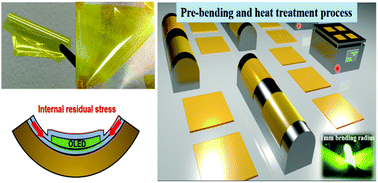Complete stress release in monolayer ALD-Al2O3 films based on mechanical equilibrium homeostasis to realize a bending radius of 1 mm†
Abstract
Low-temperature-deposited, transparent, high-barrier-performance atomic layer deposition (ALD) Al2O3 films are widely utilized to protect organic optoelectronic devices. However, because the internal compression residual stresses result in poor mechanical properties, these films are unable to realize independent encapsulation. In this work, we propose a pre-bending and substrate thermal expansion process to fabricate low-residual-stress ALD-Al2O3 films by multistep adjustment of mechanical equilibrium homeostasis, compare and analyze the key properties of the films to determine the optimal processing conditions, and adjust the surface area differences between the film and the substrate to acquire a flat-bottom encapsulation substrate. Therefore, fewer cracks form in ALD-Al2O3 deposited at 40 °C, and no significant increase in the water-vapor-transmission rate (WVTR) occurred after multiple bending processes at a 3 mm radius. Furthermore, both the bending radius for the first crack generation and crack saturation density were optimal, resulting in excellent mechanical stability, and a bending radius of 1 mm was achieved. Finally, we confirm the feasibility of the monolayer ALD-Al2O3 prepared by our process for applications in OLEDs. The encapsulated OLED maintained 94% of its initial efficiency after 10 days of bending in a harsh environment at 30 °C and 90% relative humidity.



 Please wait while we load your content...
Please wait while we load your content...